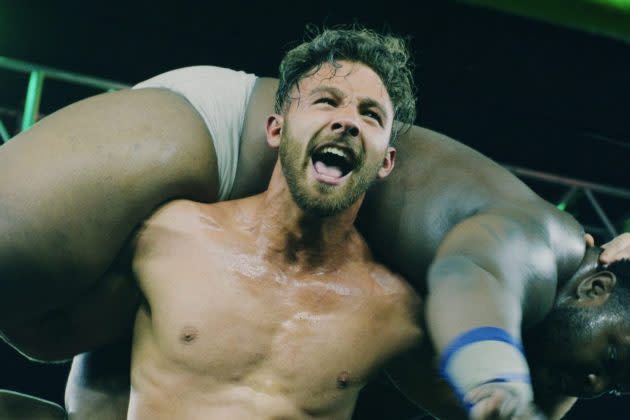Ring of Truth: The Rise of Pro Wrestling Docuseries

The behind-the-scenes world of professional wrestling was infamously closed off to the public for decades, frustrating fans who craved a glimpse of what their favorite performers were really like
outside the ring.
That all changed with the internet and social media. And now, the industry is peeling back the mystique further via a slew of docuseries about pro wrestling’s biggest stars and aspiring grapplers.
WWE has a slate of four shows with A&E, including “WWE Rivals” and “WWE’s Most Wanted Treasures.” Meanwhile, Vice TV is releasing Season 4 of the series “Dark Side of the Ring” on May 30. Also in the mix, Apple TV+ recently aired the docuseries “Monster Factory,” named after the famed pro wrestling school in New Jersey where it takes place, and TBS began airing the All Elite Wrestling show “AEW: All Access” in March.
Evan Husney, co-creator and executive producer of “Dark Side of the Ring,” says the pro wrestling doc boom is finally happening because the WWE “controlled the narrative for so long.” Only now are fans getting to see things from other perspectives.
“[WWE] controlled all the documentaries that were being put out,” he says. “When we came along with our first season, it was the first time on television in a while that you had seen a sort of journalistic approach and different looks at behind-the-scenes stories and controversies on that large of a scale.”
Also driving the wrestling docuseries explosion: nostalgia.
“The sweet spot for our demo is ’80s and ’90s nostalgia,” says Brad Abramson, A&E’s VP of documentary programming. “In WWE, that was the era of their tremendous growth. We saw that was an untapped market for stories.”
But for a show like “Monster Factory,” which follows independent wrestlers looking to break into the big leagues, it’s about letting the audience engage with the story of someone they’ve never heard of.
Galen Summer, co-showrunner of “Monster Factory,” says he was surprised by the connection he felt to the show’s subjects and how they defied his stereotypes about wrestling.
“I kind of expected it to be this more testosterone-driven space, Summer says. “The thing I didn’t anticipate was that the people were half theater geek, half comic book fan, and also athletes. We were blown away, honestly, by the community that we found.”
Pro wrestling is notorious for blurring the line between reality and in-ring story, however, which can be problematic for documentarians trying to get to the truth behind the myth. Wrestlers are known to sometimes live their gimmick, continuing to play their character even out in the real world. (Think Ric Flair, with his flamboyant robes and alligator shoes, and the Ultimate Warrior, who legally changed his name from James Hellwig to Warrior in 1993.)
Husney says that it was difficult at first to tell the difference between fact and when he and his crew were being “worked,” as they say in the biz. But eventually it became easier to detect.
“Everybody we spoke to understands what’s the in-ring gimmick and what’s the human story, and we tried to focus on the human story,” Abramson says.
In the case of “AEW: All Access,” the story became all too human when AEW star Adam Cole, who’s known for his time in WWE and Ring of Honor, was sidelined by a serious concussion in 2022.
“When we set out to do this show, I never expected to have him be on the sidelines,” says AEW CEO and head of creative Tony Khan. “I do think it made for some of the most compelling moments we’ve seen.”
And for a genre that relies on storylines and the superhuman, perhaps its most real.
More from Variety
'Dark Side of the Ring' Season 4 Trailer Teases Marty Jannetty, Abdullah the Butcher Episodes
'Dark Side of the Ring' Season 4 Sets Premiere Date at Vice TV
WrestleMania 39 Breaks Peacock Usage Record, 'Monday Night Raw' Nets Three-Year Key Demo High
(Pictured: David Goldschmidt (aka Goldy) and Hurley A. Jones Jr. (aka Bobby Buffet) in “Monster Factory”)
Best of Variety
Tony Predictions: Best Musical -- Four Stand Poised to Give ‘Kimberly Akimbo’ Some Competition
This 'Fast and Furious' Arcade Cabinet Allows You to Step Behind the Wheel as Dom Toretto
Sign up for Variety’s Newsletter. For the latest news, follow us on Facebook, Twitter, and Instagram.
